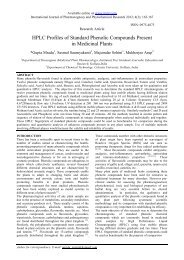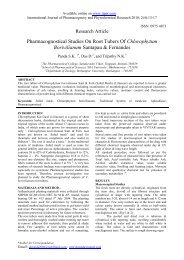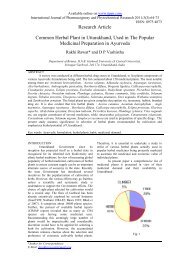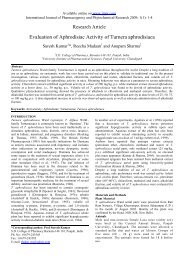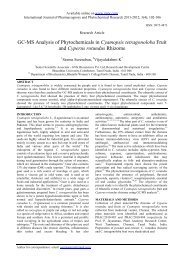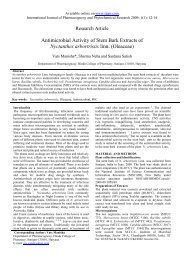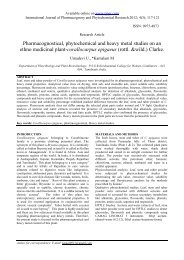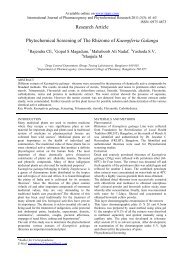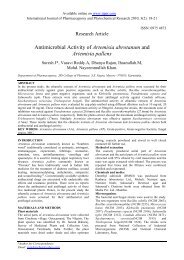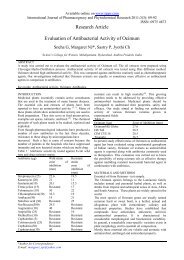antiasthmatic activity of methanolic extract of sphaeranthus indicus
antiasthmatic activity of methanolic extract of sphaeranthus indicus
antiasthmatic activity of methanolic extract of sphaeranthus indicus
Create successful ePaper yourself
Turn your PDF publications into a flip-book with our unique Google optimized e-Paper software.
Available online on www.ijppr.comInternational Journal <strong>of</strong> Pharmacognosy and Phytochemical Research 2010; 2(3): 15-19Research ArticleISSN: 0975 4873Antiasthmatic Activity <strong>of</strong> Methanolic Extract <strong>of</strong> Sphaeranthus <strong>indicus</strong>M. S. Prajapati*, M. B. Shah, A. K. Saluja, U. D. Shah, S. K. ShahDept. <strong>of</strong> Pharmacognosy and Phytochemistry, A. R. College <strong>of</strong> Pharmacy & G. H. Patel Institute <strong>of</strong> Pharmacy,Vallabh vidyanagar -388120 (Gujarat)ABSTRACTSphaeranthus <strong>indicus</strong> auct. Non L. (Asteraceae) commonly known as Gorkhmundi. It is used for various ailments inIndian system <strong>of</strong> traditional medicines. Methanolic <strong>extract</strong> <strong>of</strong> aerial parts was evaluated for <strong>antiasthmatic</strong> <strong>activity</strong>.Histamine induced bronchospasm in guinea pigs and egg albumin induced bronchospasm in guinea pig model wereperformed and various parameters were investigated like PCD time, serum bicarbonate level, differential leukocytescount and histopathological changes in lung. Biochemical estimation like glutathione (GSH) level, malondialdehyde(MDA) level and total proteins were also checked. The result showed that it significantly increased preconvulsiondyspnoea (PCD) time, decreased differential leukocyte counts and serum bicarbonate level. It decreased the oxidativeburden by reducing the MDA level and increasing the GSH level which was imbalanced in asthmatic condition, alsoshown significant action on total protein level. The drug also reduced the inflammation and dilated the bronchioles. Allthese data suggested that S. <strong>indicus</strong> is having promising <strong>antiasthmatic</strong> <strong>activity</strong>.Key words: S. <strong>indicus</strong>, Histamine, Antiasthmatic, Asteraceae and BronchospasmINTRODUCTIONAsthma is a chronic inflammatory disorder <strong>of</strong> theairways in which many cells and cellular elements play arole, in particular, mast cell, eosinophils, T-lymphocytes,macrophages, neutrophils, and epithelial cells 1 .Thepathophysiological changes occur in asthma is likeairway obstruction due to combination <strong>of</strong> various factorsinclude spasm <strong>of</strong> airway smooth muscle, edema <strong>of</strong>airway mucosa, increased mucus secretion, cellularinfiltration <strong>of</strong> the airway walls and injury anddesquamation <strong>of</strong> the airway epithelium 2,3 .Sphaeranthus <strong>indicus</strong> auct. Non L. (Asteraceae)commonly called as Gorkhmundi is found to be grown inrice fields, dry waste places and cultivated throughoutIndia in rainy season, Sri Lanka, Africa and Australiafrom sea level to 1200m altitude 4 . It is a much branched,strongly scented annual erect herb most commonly growas a weed. The plant flowers in October- January andfruits are formed from December – April 5 . According toAyurveda, this herb is hot, laxative, digestible, tonic,fattening, alterative, anthelmintic and alexipharmic. It isused in tuberculosis, bronchitis, anemia, piles, asthma,leucoderma, etc. All the parts <strong>of</strong> the plant have medicinalvalue. The juice <strong>of</strong> the plant is styptic and said to beuseful in liver and gastric disorders 6 . The sesquiterpeneglycoside isolated from S.<strong>indicus</strong> is havingimmunostimulant effect 7 . The plant is reported to possessanti-inflammatory, antimicrobial <strong>activity</strong> and woundhealing property 8, 9 . Considering the ayurvedic uses andreported activities <strong>of</strong> the drug, it is proposed toinvestigate its <strong>antiasthmatic</strong> potential using variousexperimental models.MATERIAL AND METHODSAll chemicals and solvents used were <strong>of</strong> analyticalgrades. Ketotifen fumarate was obtained as a gift samplefrom FDC Ltd., Mumbai. Histamine hydrochloride waspurchased from Chitichem, Baroda. Egg albumin,sodium dodecyl sulfate, acetic acid, hydrochloric acid,thiobarbituric acid (TBA), trichloroacetic acid, disodiumhydrogen phosphate, 5, 5’-dithiobis-2-nitrobenoic acid,sodium-potassium tartrate, sodium hydroxide, sodiumcarbonate, Folin-phenol reagent were <strong>of</strong> analytical grade.Plant material and ExtractionFully grown, fresh entire herb <strong>of</strong> Spharaenthus <strong>indicus</strong>auct. Non L. was collected in the month <strong>of</strong> Decemberfrom Vallabh Vidyanagar. The herb was authenticatedby a taxonomist at the Department <strong>of</strong> Bioscience, SardarPatel University, and Vallabh Vidyanagar. A voucherspecimen (no argh-7) was deposited in the Department<strong>of</strong> Pharmacognosy, A. R. College <strong>of</strong> Pharmacy, VallabhVidyanagar. The aerial parts were cleaned, dried at roomtemperature, powdered to coarse powder (60 #) andstored in air tight container. 5 kg <strong>of</strong> dried aerial parts <strong>of</strong>Sphaeranthus <strong>indicus</strong> was exhaustively <strong>extract</strong>ed bysubjecting to reflux below 80 0 C (3 X 5 L). Thecombined methanol <strong>extract</strong> was distilled and evaporatedto dryness (25 %w/w). A weighed quantity <strong>of</strong> the <strong>extract</strong>was taken and suspension was prepared using Tween 80and was used for further study.AnimalsGuinea pigs (450-600 gms) were procured from AnimalVaccine Institute, Gandhinagar. All animals were housedat ambient temperature (21±10C) and relative humidity(55±5 %) with fixed 12h/12h light/dark cycle. Animalshad free access to standard pellet diet and water given ad*Author for correspondence: manishasprajapati@gmail.com
Prajapati et.al./ Antiasthmatic <strong>activity</strong> <strong>of</strong> <strong>methanolic</strong> <strong>extract</strong>…libitum. The experimental protocol was approved byInstitutional Animal Ethical Committee as per theguidance <strong>of</strong> committee for the purpose <strong>of</strong> Control andSupervision <strong>of</strong> Experiments on Animals (CPCSEA),Ministry <strong>of</strong> Social Justice and Empowerment,Government <strong>of</strong> India.Table: 1 Effect <strong>of</strong> Sphaeranthus <strong>indicus</strong> on PCDtime in guinea pigs after acute treatment.Treatment group % increase in time <strong>of</strong>PCDNormal control group 5.17 ± 2.54Ketotifen group (1mg/kg) 87.35±3.80 @MSI group (150mg/kg)MSI group (300mg/kg)64.26±2.62 @36.34±4.8 @(sensitized group) and Group III received <strong>methanolic</strong><strong>extract</strong> <strong>of</strong> Sphaeranthus <strong>indicus</strong> (MSI group)(150mg/kg).Normal groupMSI group (450mg/kg) 29.63±3.9 @@ Significantly different from control group (p < 0.05)MSI- Methanolic <strong>extract</strong> <strong>of</strong> aerial part <strong>of</strong> S. <strong>indicus</strong>In vivo <strong>antiasthmatic</strong> <strong>activity</strong>Histamine induced bronchospasm in guinea pigThe guinea pigs (Animal breeding centre) were kept in aclosed chamber and exposed to an aerosol <strong>of</strong> 0.1 percenthistamine hydrochloride and time for preconvulsiondyspnoea was noted. As soon as preconvulsion dyspnoea(PCD) commenced, animals were removed from thechamber and placed in fresh air to recover. This time forPCD was taken as basal value. After 15 days <strong>of</strong> wash outperiod the same animals were randomly divided into fivegroups each containing six animals. Group I receiveddistilled water (normal control); Group II receivedKetotifen (1 mg/kg, P.O.) (Standard control) and GroupIII, IV and V received <strong>methanolic</strong> <strong>extract</strong> <strong>of</strong> S. <strong>indicus</strong>(MSI group) in divided doses 150, 300 and 450 mg/kgrespectively. The suspension <strong>of</strong> drugs was administeredorally. Two hours after the drugs treatment, animalswere exposed to histamine aerosol and times for PCDwere noted. The effect <strong>of</strong> drug was calculated by thefollowing formula 10% increase in PCD time = [1 – T1/T2] X 100Where, T1 = time for PCD onset on day 0, T2 = time forPCD onset after drug treatment.Egg albumin induced bronchospasm in consciousGuinea pigsHartley strain Guinea pigs <strong>of</strong> either sex weighing 400-600 gm were selected. The animals were examined forthe following parameters:Eosinophil and macrophages count in thebronchoalveolar fluidSerum bicarbonate levelMeasurement <strong>of</strong> MDA levelMeasurement <strong>of</strong> GSH levelMeasurement <strong>of</strong> total protein levelHistopathologyThe animals were randomly divided into three groupseach containing six animals. Group I received distilledwater (normal control), Group II received egg albuminSensitized groupMSI groupFig. 1 Histopathological studiesEosinophil and macrophages count in thebronchoalveolar fluidThe suspension <strong>of</strong> drugs was administered orally. Theguinea pigs <strong>of</strong> all the groups except Group I weresensitized with egg albumin (1 ml, 10% w/v).Theanimals <strong>of</strong> Group III was dosed once daily for fifteendays with the suspension <strong>of</strong> drug. Two hours after thelast dose <strong>of</strong> drug administration on fifteen days all theanimals except Group I animals were challenged withegg albumin (0.5 ml, 2% w/v) through saphenous vein.After 3 hours <strong>of</strong> the challenge <strong>of</strong> the egg albumin or justprior to death <strong>of</strong> animals, whichever was earlier, thetracheobronchial tree was lavaged with 10 ml <strong>of</strong> salineand the fluid so collected was centrifuged at 2000 rpmfor 5 minutes and the pellet was resuspended in 0.5 mlsaline. 0.2 ml <strong>of</strong> geimsa stain in buffered saline (pH 6.5)was added to it. After 5 minute the number <strong>of</strong> each type<strong>of</strong> leukocytes in 0.5 ml fluids was determined under themicroscope 450 X magnifications. The results obtainedwere compared with unsensitized and untreated eggalbumin sensitized guinea pig. 11Serum bicarbonate levelSerum is suitable specimens for measurement <strong>of</strong>bicarbonate level. The whole blood should be collectedand handled anaerobically to minimize exposure to air.Serum bicarbonate is stable for one hour when storedunder anaerobic conditions in an ice bath. Lable one testIJPPR September - November 2010, Volume 2, Issue 3 (15-19) 16
Prajapati et.al./ Antiasthmatic <strong>activity</strong> <strong>of</strong> <strong>methanolic</strong> <strong>extract</strong>…tube or cuvette for a reagent blank. Calibrator, controisand unknown sample. Add 1 ml <strong>of</strong> completely dissolvedreagent to each tube or Cuvette. Add 0.01 ml <strong>of</strong> H 2 O tothe reagent blank and 0.01 ml <strong>of</strong> calibrator, controls andunknown sample to the appropriately labeled tube. Mixand incubate for 5min and measure the absorbance at380 nm. 12Table: 2 Effect <strong>of</strong> MSI on differential leukocytecounts <strong>of</strong> the bronchoalveolar lavage (BAL) fluidNormalcontrolgroupSensitizedgroupMSI group(150mg/kg)TLC/cmm7134.16± 13440.16 11422.5 ±101.79 ± 315.9 # 537.18 $Polymorphs 20.5 ± 37.74 ±count/cmm 0.83 0.93 # 34.09 ± 1.29 $Lymphocyte 49.79 ± 58.86 ±count/cmm 0.66 0.76 # 52.18 ± 1.44 $Eosinophil 6.21 ± 14.05 ±count/cmm 0.31 0.62 # 8.98 ± 0.57 $Monocytecount/cmm4.83±0.3313.41 ±0.87 # 7.01 ± 0.91 $# Significantly different from control (p
Prajapati et.al./ Antiasthmatic <strong>activity</strong> <strong>of</strong> <strong>methanolic</strong> <strong>extract</strong>…in diagnosis and treatment. Lloyd-lake London 16. Fireman, P. Allergy Asthma Proc. 2003; 24 2: 79-831979; chapter IV: 78-113. 17. Hulya Ercan, Esra Birben, Evrim A. Dizdar, Ozlem13. J. A. Buege, S. D. Aust, Microsomal lipidperoxidation method. Enzymology 1978; 52; 302–Keskin, Cagatay Karaaslan, Ozge U. Soyer, RaziyeDut, Cansin Sackesen, Tanju Besler, and Omer310.Kalayci, “Oxidative stress and genetic and14. C. W. Owens, R.V. Belcher, Biochem. J. 1965; 94,705–711.15. Busse, W. W. and Lemanske, R. F. Jr. Asthma Nepidemiologic determinants <strong>of</strong> oxidant injury inchildhood asthma”, J allergy clin immunol. 2006;18 (5), 1097-1104Engl. J. Med. 2001; 344: 350-362IJPPR September - November 2010, Volume 2, Issue 3 (15-19) 19



